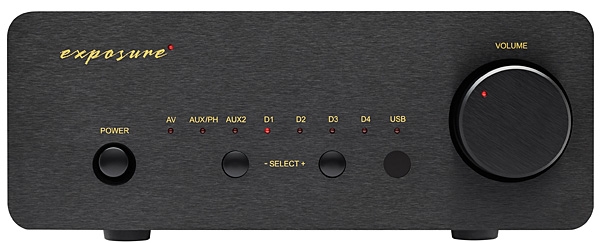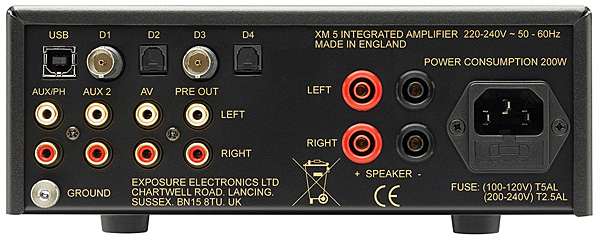| Columns Retired Columns & Blogs |
Denon PMA-1600NE ($1,599) integrated amp would be a good comparison :-) .........

Make that triply nostalgic: Some of us look back in longing not only at mythic musical performances but at fondly remembered playback gear—things that excelled, often uniquely, at suggesting one or another aspect of real music, yet are no longer in production. So forgive me for noting yet again that one of the finest, most effectively musical playback systems I've ever heard at a hi-fi show was in the late 1980s, when a now-defunct American distributor of British hi-fi gear paired Linn's LP12 turntable and humblest loudspeaker, the Kan, with a then-new integrated amplifier called the X, from British manufacturer Exposure Electronics. That the system was relatively affordable may have contributed to my memory-sear.
Prior to the X's introduction, Exposure's amps and preamps had the reputation of being worthy alternatives to those from Naim Audio. Naim's electronics were by then well established—and well distinguished, owing to a number of qualities, especially the emphasis placed on the benefits of the high-quality outboard power supplies they made for their preamps and, later, their digital sources. Exposure not only followed that lead, they built their gear into aluminum enclosures of superficially similar appearance and size—the latter typically modest by trophy-audio standards—and eschewed the American norm of wiring a system with long interconnects and short speaker cables in favor of the opposite approach. That said, Exposure never picked up on Naim's preferred amplifier architecture of all-NPN "quasi-complementary" output circuitry; instead, they stuck with tried-and-true complementary pairs of NPN and PNP transistors operated in class-AB.
Decades later, Exposure endures, as does their apparent interest in making perfectionist-quality solid-state amps of modest size and price. In the second half of 2018 they introduced their XM series of shoebox-sized electronics; it includes the XM5 integrated amplifier ($1795), which also contains a 24-bit/192kHz D/A processor.
Description
Measuring 8.6" wide by 3.5" high by 14.3" deep—dimensions that don't stray far from the 8" by 3" by 11" of the original Naim Nait—Exposure's XM5 has at its heart a 60Wpc output stage using complementary pairs of Toshiba bipolar transistors operated in class-AB. Allied to that are an active line-level preamplifier and a phono stage suitable for use with moving-magnet (MM) cartridges. (Unusually, Exposure lists the specifications for the preamp and output stages separately.) The XM5 has three analog inputs, all on RCA jacks: one for MM phono (with the slightly confusing label Aux/Ph), one for line-level sources (Aux 2), and one fixed-level input for use with an A/V receiver (AV). Also provided is a pair of preamplifier output (Pre Out) jacks, also RCAs, intended for use with an auxiliary power amplifier in systems in which the user's speakers can be biamped. In such installations, Exposure recommends using the XM5's own output section to power the tweeters and the outboard amp to power the woofers.

The XM5's D/A processor is built around a WM8742 DAC chip from the UK firm Wolfson Microelectronics. The Exposure provides five digital inputs: four S/PDIF (two optical via TosLink, two coaxial via BNC), and one USB Type B. That last one allows DSD playback (DoP) up to DSD64.
I didn't bother photographing the inside of the XM5, as there's not a great deal one can see. Under its wrap-style aluminum cover, which is finished in black textured paint, is the DAC board, which is installed upside down and takes up more than half the amp's width and most of its depth. Its mechanical connections are limited to two standoffs fastened to the main board; the five digital-input jacks, which are fastened to the rear end of the DAC board, protrude through openings made for them in the chassis, but aren't fastened to the chassis itself. (The DAC board seems rugged enough, but I advise users not to push too hard when connecting their digital links.) That board obscures most of the even larger main board below it—and below that are the output transistors, fastened to aluminum heatsink bars that are themselves fastened to the bottom of the chassis (or so it seemed—I spared myself the chore of taking the whole thing apart for a better look). I also noted the XM5's hefty Kendell reservoir capacitors, and a custom-wound Noratel toroidal mains transformer that sported a fanciful drawing of a hedgehog.
Installation and setup
Also like those modestly-sized solid-state amps of yore, the Exposure XM5's speaker connectors are limited to one pair of banana sockets per channel. That was fine with me: I gave up spade lugs and bare wire years ago, for the reason, possibly imagined, that banana plugs sound better to me. (Less controversial is the notion that they're easier to use.) Adapters exist, but are not included, for those who've already invested in spade-terminated speaker cables.
Thinking about cable terminations was the most difficult part of setting up the XM5, which weighs 11 lb: light enough to make installation a snap, yet not so light that stiff cables, once connected, are likely to push it around. I connected my Hegel Music Systems Mohican CD player to the XM5's Aux 2 input with an Audio Note AN-Vx interconnect, and used an AudioQuest Carbon USB link to deliver the output of my MacBook Air laptop computer, running Roon v.1.5, to its USB input. I drove the Exposure's MM phono stage with the output of my Auditorium 23 Hommage T1 MC step-up transformer via Luna Red interconnects. The XM5's stock AC cord was the only one I used.
The XM5 comes with Exposure's HS 3 remote-control handset, but I preferred adjusting the listening level with the amp's large volume knob—this connects to the XM5's Alps volume pot, which is motorized for remote control—and choosing inputs with the amp's two Select buttons, which toggle through its eight inputs. I ran in the XM5 by playing a CD on repeat for a day.
Listening
Through my Altec Flamenco speakers, the Exposure's character was spatially slightly distant—an impression whose flames were fed by a slightly dull overall tonal balance—and lacking an abundance of well-saturated timbral colors. But its sound was free from the top-end etch one sometimes braces for with relatively affordable electronics. On the many dynamic peaks in the recording of Beethoven's Piano Concerto 5 by Clifford Curzon, Hans Knappertsbusch, and the Vienna Philharmonic (Decca/Speakers Corner SXL 2002), the XM5 sounded a bit compressed, but never harsh or grossly distorted. String texture was okay, and crispness—and temporal precision—of note attacks were very good: At the end of the Adagio un poco moto, the moment when the third movement's theme is introduced was as stirring as I've ever heard from this great record.
I spent a few more days listening to the Exposure-Altec pairing, noting throughout more or less the same combinations of strengths and weaknesses: great musical timing allied with sound that was never harsh but also never quite as open, clear, or colorful as I wished. It was when I switched from the Altecs to the DeVore Fidelity Orangutan O/93s that the Exposure came into its own.

Denon PMA-1600NE ($1,599) integrated amp would be a good comparison :-) .........

... 60W output rating, one could just as well compare it to the $600 Denon PMA-800NE and/or the $700 Marantz PM7005.

Denon and Marantz units also have tone controls ..... if such things matter :-) .......

Those tone controls are centered at 100Hz and 10KHz ....... Most of the listeners seem to prefer those types of tone controls :-) .........

Yet another component review where the enthusiasm is dependent on the right combination, where a different combination of perfectly good components isn't as good as a different combination.
The differences in the review between being hooked to the Altecs versus the deVores is striking. This little box went from just OK to enjoyable, by switching speakers. That's my greatest sadness about the current trends in audio retailing. There are fewer. Those that exist have stripped their lines down to a few manufacturers. That stripped down inventory definitely has its negatives. I've heard some speakers that I know are fantastic (given the right sources and amps) that sounded dull and flat, because the retailer's limited palette of options didn't match well with them.
Putting a system together, where the components all play well with each other, is now down to guesswork.
My best sounding system is one I got almost 20 years ago... when I could select from and test several different speakers and integrated amps, and then test a few different speaker cabling options. Over the course of a few days, I found a harmonious combination. When the integrated had to go for repair and I had a substitute in the system, suddenly I hated the speakers. When the integrated went up in a spectacular show of flames, I went through a half dozen different units (on 30 day trial, and each time I felt vaguely guilty about the return) to find the one that worked with the system.
I suspect this is a problem limited to the affordable range, and not the very high end.

Yes it seem pretty much to be the audiophile trend to leave tone controls away. The user is forced to a mouse's wheel of buying new speakers, players, amps, speakers, players, amps etc. ad infinitum! Makes sellers and some manufacturers happy...